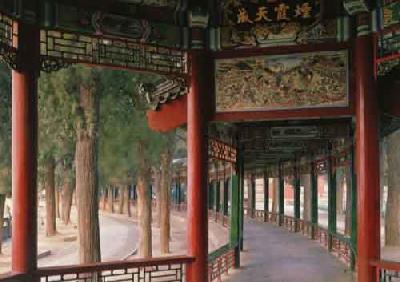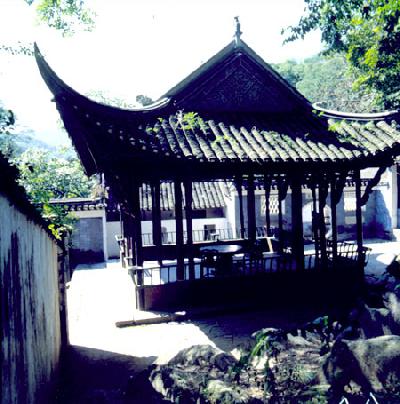| Art Q&A > Architecture |
|
|
Chinese Lang and Ting
The Chinese Lang (covered corridor) and Ting (pavilion or kiosk) represent two typical architectural styles in Chinese landscape gardening.
The Chinese Lang can be divided into You Lang which links two or more buildings, Hui Lang (the winding corridor), Qu Lang (the zigzag corridor), Hua Lang which is used for the display of potted flowers, and Shui Lang which borders on lakes or goes over ponds.
Among all the classical corridors in China, Chang Lang (the Long Corridor) in Beijing's Summer Palace is one of the most distinguished and a unique treasure in the art of gardening arrangement. An exquisite winding structure of 728 meters, it stretches its 273 bays between the hill and the lake, broken at intervals by four double-eaved octagonal pavilions, which represent the four seasons of the year. All its beams are painted with colored pictures of landscapes, human figures, flowers, birds and scenes of historical and popular stories. These paintings total more than 40,000 in number, and the visitor would need eight hours just to linger two seconds before each picture.
As history records, the Long Corridor was built by Emperor Qianlong of the Qing Dynasty (1644-1911) in order that his mother might safely enjoy the scenes of rain or snow over the lake.
Famous private Chinese gardens, located mostly in the southern province, are often ornamented with corridors. In Suzhou's Zhuozheng Garden (The Humble Administrator's Garden), part of the winding corridor is erected over a pond and has been described as a "rainbow over water". With its reflection in the water, sometimes ruffled by a breeze, it is a favorite spot for visitors to take snapshots of themselves. In Liu Garden (The Lingering Garden), another well-known garden of Suzhou, the buildings, pavilion, terrace, hall and tower are linked by a 600-meter-long corridor. Its wooden walls have fancy cut-through window through which visitors can enjoy the surrounding scenes, and they are also inset with 300 stone-engravings of calligraphy works and poems by famous ancient masters; both the windows and the engravings are regarded as masterpieces of their respective kinds.
Ting has a long history in China. Differing from the present functions, in the Zhou Dynasty (11th contrary-256 BC), Ting was a sentry at the frontier fortress for defense. Later, in the Qin and Han dynasties (about 200 AD), Ting changed into a name for a certain institution in the countryside. It was in the Tang Dynasty (618-907) that Ting finally developed into a typical architectural style in Chinese landscape gardening.
All pavilions described as Ting have this in common: they have columns to support the roof, but no walls. In parks or at scenic spots, pavilions are built on slopes to command the panorama or on lakeside to create intriguing images in the water. They are not only part of the landscape but also belvederes from which to enjoy the scenery.
Ting also functions differently. The wayside pavilion is called Liang Ting (cooling kiosk) to provide people with shade from the sun and protection from the rain, and also a place to rest. The Shibei Ting (stele pavilion) gives a roof to a stone tablet usually on which were engraved records of an important event. Ting also stands on some bridges or over water-wells.
Rare among pavilions are those built of bronze. The most famous of this kind is Baoyun Ge (Pavilion of Precious Clouds) in Beijing's Summer Palace. The entire structure including its roof and columns is cast in bronze. Metallic blue in color, it is 7.5 meters tall and weighs 207 tons. Elegant and dignified, it is popularly known as the Gold Pavilion.
The largest Ting in China is also in the Summer Palace. The ancient building, named Kuoru Ting (the Pavilion of Expanse), has a floor space of 130 square meters. Its roof, converging in a crown on top and resting on three rings of columns (24 round ones and 16 square ones), is octagonal in form and has two eaves. With all its woodwork colorfully painted, the pavilion looks at once poised and majestic, well in harmony with the surrounding landscape.
In Beijing's Jingshan Park, there are five pavilions on the ridges. From east to west they are: Guanmiao Ting (Wonderful View Pavilion), Zhoushang Ting (Surrounding View Pavilion), Wanchun Ting (Everlasting Spring Pavilion), Fulan Ting (Panoramic View Pavilion) and Jifang Ting (Harmonious Fragrance Pavilion). From the hilltop, visitors can have a bird's-eye view of the city. There used to be a bronze statue of a god in each of the pavilions. Unfortunately four of them were stolen by the allied forces of the eight world powers in 1,900, and the one on the uppermost pavilion was totally damaged.
In modern times, kiosks (also called Ting in Chinese) have been erected in urban areas as postal stalls, newsstands or photographers' sheds for snapshot services. |
||||||
All rights reserved. Reproduction of text for non-commercial purposes is permitted provided that both the source and author are acknowledged and a notifying email is sent to us. |
||||||
 |
 Lang: Covered Corridor
Lang: Covered Corridor
 Ting: Pavilion
Ting: Pavilion